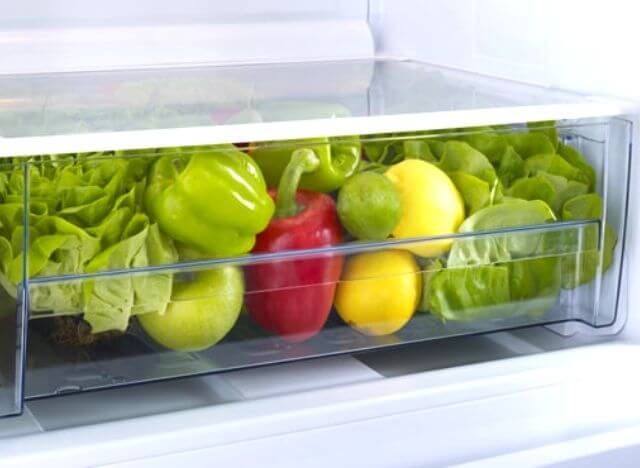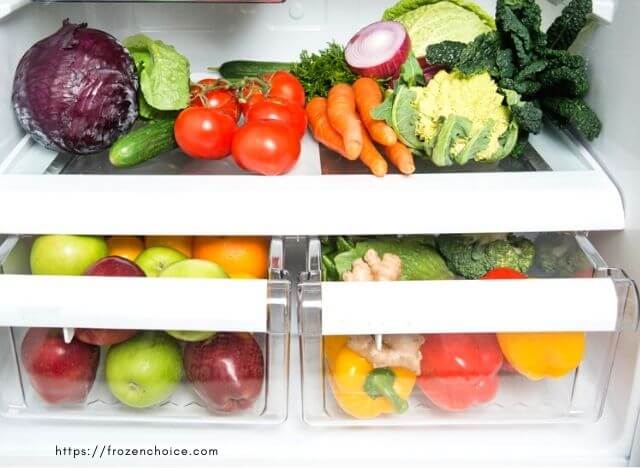Your body will only feel comfortable if the air humidity is within a certain range. The same can be said about food kept in the fridge. Moisture is essential to be in the fridge, and gladly it is there all the time. However, too much moisture is bad for the food since mold or bacteria can grow rapidly, which can put out unpleasant smells and cause the food to decay fast. Therefore, monitoring and adjust the humidity is important. So how to control humidity in refrigerator?
What is humidity in the fridge?
Humidity is the presence of water vapor in a certain volume of air. Water vapor is simply the gaseous state of water and is created when water evaporates.
There is also a saturation point where beyond this point in a certain volume and temperature of air, you can no longer add water mass. This saturation point increases as the temperature increases.
What causes the humidity in a refrigerator?
The common reasons are:
Vents are blocked: After a long time, the ice build-ups will clog some parts of the fridge such as vents and drains.
Thermostats are broken. When the thermostat does not operate smoothly, it can cause the condensation to freeze and thaw repeatedly. This will increase the humidity level in the fridge.
Door seals have problem: If the fridge door is faulty and cannot close tightly as an airtight seal, there is an opportunity for warm air to get in. As a result, the excessive condensation will occur.
Besides, some kinds of foods can change the fridge humidity. For example, hot food can increase the level of humidity. In addition, if the fridge door opens for too long, the humidity will get higher.

The importance of humidity
Humidity is very crucial for water exchange between the land creatures (or food in the fridge) and the air. In high humidity air, water exchange in land creatures by sweating decreases.
For human, high humidity and high heat disrupt the blood flow across the body, which can cause fatigue, heat stroke, or even hyperthermia.
In high humidity level (85 to 95 percent), the airflow will be closed and helps to maintain the moist for veggies and keep them fresh in fridge for a longer period of time.
Humidity in the fridge for certain types of food
Inside the fridge, it is cold and dry with the average temperature of 32-40 degrees Fahrenheit and the relative humidity is about 65 percent.
There are two major humidity settings that are suitable for certain types of food: high-humidity and low-humidity. The high humidity is perfect for leafy vegetables that can wilt quickly. Meanwhile, the low-humidity setting is best for food that can rot easily.
High humidity
Generally, you should keep food in this setting that is prone to losing moisture and affected by ethylene gas. It should be ideal for plants that easily wilt.
Some of the fruits and vegetables that stay safe in high-humidity setting, between 85 percent and 95 percent, includes:
- Unripe banana, Eggplant, Okra, Peppers, Strawberries, Summer Squash, Watermelon
- Asparagus, Beets, Celery, Radishes, Corn and Turnips
- Belgian endive, Broccoli, Brussels sprouts, Cabbage, Carrots, Cauliflower, Cucumbers, Green beans, Peas
- Cilantro, Dill, Parsley, Thyme,…
- Kale, Lettuces, Spinach, Swiss chard, Watercress,…
Low humidity
You should keep food in this setting that isn’t prone to losing moisture and produces high amounts of ethylene gas. It should be ideal for plants that rot quickly. Normally, it’s best to use low-humidity drawers for fruits.
Some of the fruits that are ideal in low-humidity setting includes:
- Apples, Avocados, Ripe Banana, Cantaloupes, Figs, Honeydew Melons, Kiwis, Mangoes, Papayas, Pears, Plantains
- Apricots, Nectarines, Plums, Peaches,…
Further reading: How Often Should You Defrost a Fridge?
Why are there fridge drawers designed for separated food storage?
Separated drawers are for better preservation of certain types of food that act differently in different humidity. Also, fridge drawers are great for keeping away food that can ruin other food when placed together.
Certain food can ruin the freshness of other food because of ethylene gas.
Ethylene gas is released by certain fruits as they ripen, which can further ripen other fruits. This is why if you put an amount of ripe fruit along with unripe fruits, the unripe fruit will ripen faster.
However, this gas will decrease the freshness of other food like lettuce. So by using separated drawers, you can trap the ethylene away from vulnerable food.
Tips for using humidity drawers
Do not fill the drawer
The crisper drawer works best when it’s 2/3 full, so you should not fill them too much. In order to preserve fruits, foods, vegetables for a long time and the best health, please keep in mind “everything should be in moderation”, do not pack drawers too tightly.
Arrange your food in good order
If the food is too tight and the weight is too large, it will affect the quality of others. Some heavy items will damage more fragile items.
Take care of the fridge
As for the rest of the fridge, you should not overfill it as it can cause poor air circulation and lead to contaminated food. Make sure your foods are not spoiled before putting into the drawers.
Check the fridge regularly to find out the damaged items and you should discard them before they affect other food inside the drawer and the refrigerator.
Further reading: How to Prevent Mold in Refrigerator
How to control the humidity level in your refrigerator
To control humidity in refrigerator, you need to use various means to remove and monitor the humidity in the fridge. Start by cleaning the fridge, then using dehumidifiers, small fans, or baking sodas.
Here are steps to remove excess humidity.
Step 1: Clean the fridge
This step leans more toward protecting your health than controlling humidity, although any food that has water inside can somewhat contribute to the overall humidity of the fridge.
It is time to remove spoiled food, partly or full condiment bottles.
You can mix water with dish soap to clean the fridge’s interior and use chlorine bleach to remove the smell or molds.
Step 2: Use devices or solutions to remove the humidity
- Desiccant dehumidifier: This device fits well in the fridge and can absorb water vapor (to reduce humidity), ethylene gas, and odors
- Small fans: These devices can remove humidity away from the fridge
- Baking soda: You can put a box of baking soda to absorb humidity and odors, though you need to replace the box once per month
Step 3: Check the door
Check the gasket around the door to make sure the door is sealed tightly. The outside air leaking in can bring extra humidity inside and ruin the food.
Miscellaneous tips
- Get a thermometer to better monitor the temperature
- Use container with matching lips and give them some distance between each other for better air circulation
- Put the right amount of food in the fridge
Conclusion
You can control the humidity in refrigerator by first removing spoiled food. Then, you can use multiple methods of removing the humidity like dehumidifiers, fans, baking soda, etc. Also, only put a certain amount of food inside the fridge and keep them apart from each other so that humidity doesn’t build up overtime.
Understanding about the humidity in the fridge and knowing where to store different types of food, you can maintain the quality and freshness of food for the longest possible time.
Reference
1. Control Humidity in a Fridge, shinymodern.com, Retrieved on Jan. 5, 2022
2. The Right Way to Use Your Refrigerator’s Crisper Drawer, tasteofhome.com, Retrieved on Jan. 5, 2022

